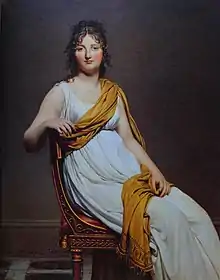Portrait of Madeleine
Portrait of Madeleine, formerly known as Portrait of a Black Woman (French: Portrait d'une femme noire or Portrait d'une negresse), is an oil-on-canvas painting by the French artist Marie-Guillemine Benoist. It was exhibited at the Paris Salon in 1800, was acquired by Louis XVIII for the French state in 1818, and remains in the collection of the Louvre.

Description
The half-length portrait measures 81 cm × 65 cm (32 in × 26 in). It depicts a young black woman, sitting in a gilt armchair mostly covered with a blue cloth, in front of a plain light background. She is seated in a three-quarter position towards her left, but her head turns to look directly at the viewer with a self-assured expression. She is wearing a white cloth tied as a headdress, and a white dress tied with a red cord. The loose end of the headcloth hangs down on the left side of her face, but her right ear is visible with a hoop hearing. Her right arm rests in her lap; her left arm is holding up the dress, but it has slipped down to reveal her right breast. Her legs fall outside the frame. The realistic dark skin tones – long considered a challenging topic for European artists – shows Benoit's artistic skill. It is signed by the subject's right hand with the artist's maiden name and married names: "Laville Leroulx / f. Benoist" ("f" for "femme", or "wife of").
The composition has similarities to Benoist's 1802 portrait of Madame Philippe Panon Desbassayns de Richemont and her son Eugène, now held by the Metropolitan Museum of Art.
.jpg.webp)
Exhibition
The painting was first exhibited at the 1800 Paris Salon as Portrait d'une négresse. Along with three other works by Benoist, the painting was acquired by Louis XVIII for France in 1818 for a total price of 11,000 francs. Initially held at the Luxembourg Palace, it has been in the collection at the Louvre for many years.
The painting was renamed Portrait de Madeleine after recent scholarship led to the identification of the subject in 2019 as a woman named Madeleine who came to France from Guadeloupe after slavery was abolished in France and its colonies in 1794, and who worked as a servant for Benoist's in-laws, the Benoist-Cavays.
Interpretation
The subject – a woman of colour – was unusual at the time: the only other portrait of a person of colour at the Paris Salon in this period was Anne-Louis Girodet de Roussy-Trioson's 1797 portrait of Jean-Baptiste Belley.
Its enigmatic presentation and apparent internal contradictions have prompted much speculation about the artist's motivation and intentions, with recent interpretations focussing on ideas of slavery, race, gender, class, and their interactions.
Madeline was a servant, yet is depicted in a wealthy milieu, wearing jewellery and sitting on an expensive chair. Most paintings of the period that include black women show them as servants to a white woman; while Madeline sits alone, she is working as a model to the unseen Benoist. The simple white clothes have a neoclassical air, similar to other contemporary portraits such as Jacques-Louis David’s 1799 portrait of Henriette de Verninac. The bared breast would be unusual for a portrait painting, and suggests an allegory or mythological subject, or possibly alludes to the slave trade. The colours – red, white, blue – parallel the colours of the French revolutionary tricolour adopted in 1789, and may suggest an allusion to Marianne, a female personification of liberty and of France itself.
Painted in the brief period between the abolition of slavery in 1794 and the reinstatement of slavery in French colonies by Napoleon in 1802, the work has been taken as a symbol of women's emancipation and black people's rights.

 Jacques-Louis David, portrait of Henriette de Verninac, 1799, Louvre
Jacques-Louis David, portrait of Henriette de Verninac, 1799, Louvre_and_Her_Son%252C_Eug%C3%A8ne_(1800%E2%80%931859)_MET_DT1995.jpg.webp) Benoist, portrait of Madame Philippe Panon Desbassayns de Richemont (Jeanne Eglé Mourgue) and Her Son Eugène, 1802, Metropolitan Museum of Art
Benoist, portrait of Madame Philippe Panon Desbassayns de Richemont (Jeanne Eglé Mourgue) and Her Son Eugène, 1802, Metropolitan Museum of Art
References
- Portrait d'une femme noire, 1800, Marie-Guillemine Benoist, Louvre
- Dr. Susan Waller, "Marie-Guillemine Benoist, Portrait of Madeleine," in Smarthistory, September 26, 2018.
- James Smalls, "Slavery is a Woman: 'Race,' Gender, and Visuality in Marie Benoist's Portrait d'une négresse (1800)", Nineteenth-Century Art Worldwide 3, no. 1 (Spring 2004)
- "Musée d’Orsay Renames Manet’s 'Olympia' and Other Works in Honor of Their Little-Known Black Models, Meilan Solly, Smithsonian magazine, March 27, 2019
- "Slavery and Abolition", in Art in Revolution: Nineteenth-Century Visual Culture, Jingyue Zhang